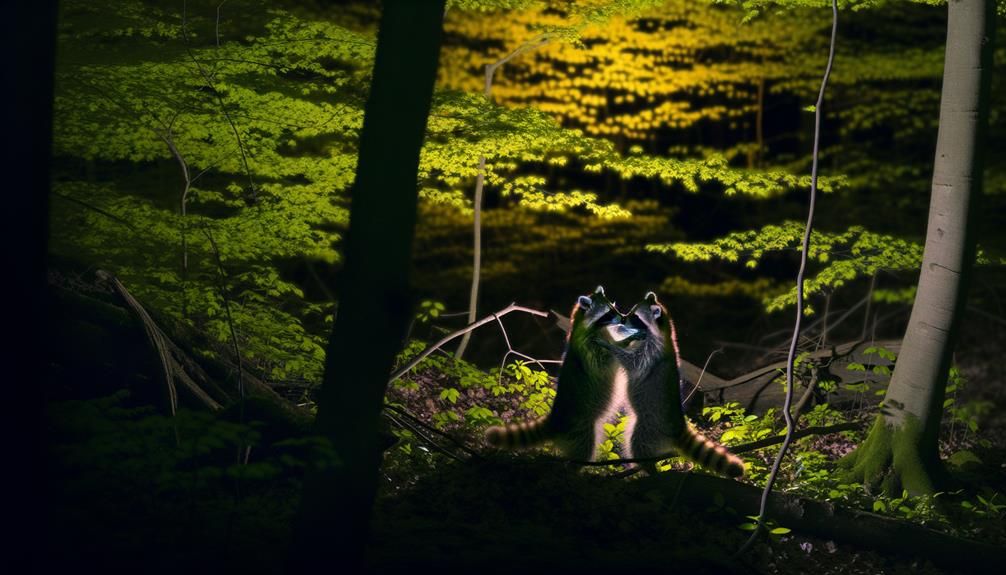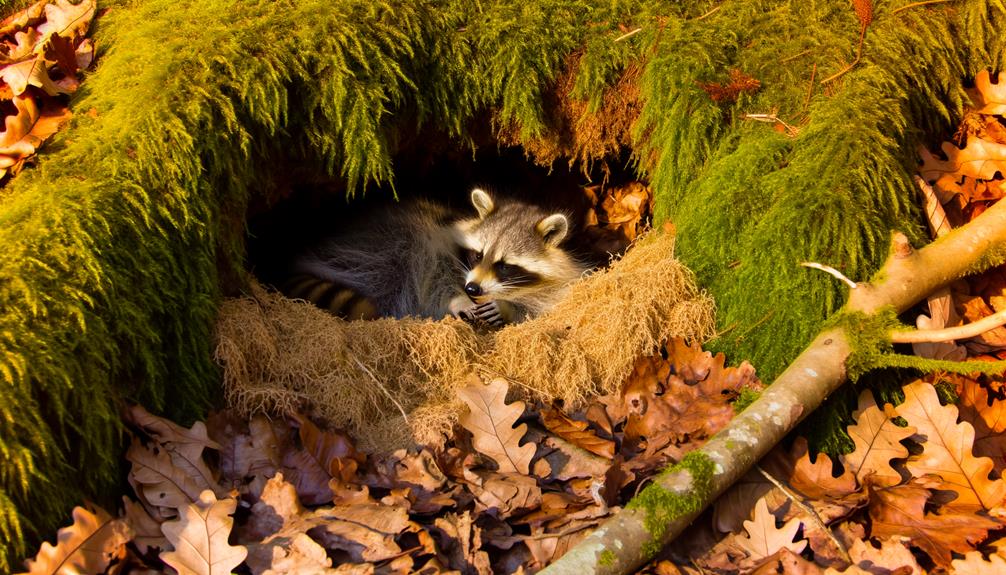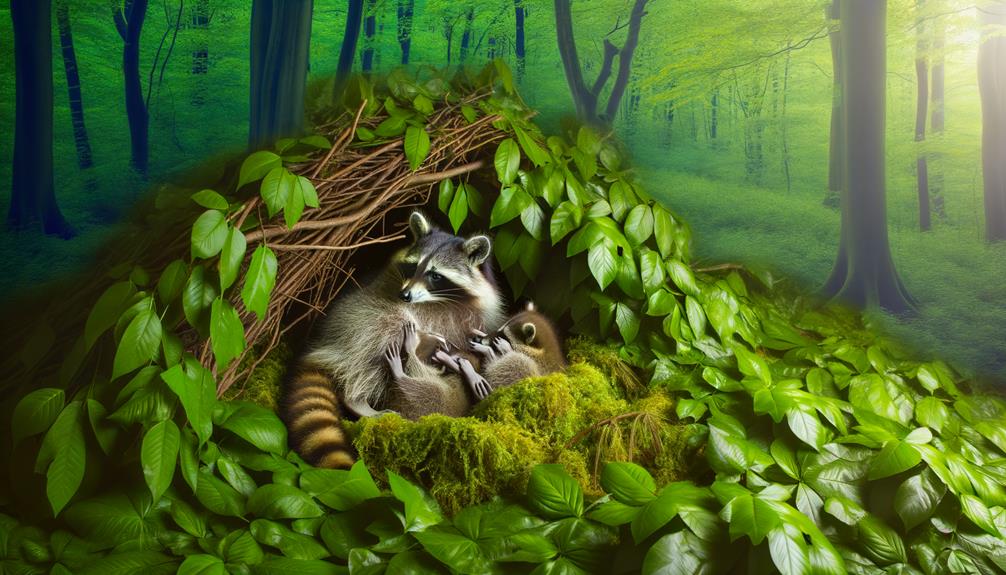Do Raccoons Give Live Birth: A Guide to Their Process
Raccoons give live birth after a gestation period lasting approximately 63 to 65 days. The parturition process results in a litter of 2 to 5 altricial kits, which are neonates that are born blind, deaf, and dependent on maternal care.
Female raccoons exhibit selective and brief courtship behaviors during peak breeding seasons, specifically from January to June. Subsequently, they prepare den sites with nesting materials to secure the safety and warmth of the offspring.
Maternal care includes continuous nursing and protective behaviors against potential predators. Those interested in raccoon reproductive behaviors and offspring development will find extensive details on these processes.

Key Takeaways
- Raccoons give birth to live young, known as kits.
- The gestation period for raccoons is 63-65 days.
- Newborn raccoons are altricial, meaning they are born blind and dependent.
- Litter sizes typically range from 2 to 5 kits.
- Kits are born during periods of abundant food for better survival rates.
Raccoon Reproductive Cycle

The raccoon reproductive cycle is characterized by a distinct breeding season, typically occurring between January and June, during which females undergo estrus and become receptive to mating. During this period, estrus lasts approximately four to five days, during which time the female exhibits heightened sexual receptivity.
Ovulation is induced by copulatory stimuli, ensuring fertilization. Once fertilized, the gestation period extends for about 63 to 65 days. Parturition, or the act of giving birth, generally results in a litter size ranging from two to five offspring, known as kits.
Neonatal kits are altricial, meaning they are born underdeveloped, blind, and dependent on maternal care. The mother provides nourishment and protection, enabling the kits to progress through critical growth stages.
Mating Season Timing
Raccoon mating season timing is influenced by various environmental factors, including temperature and food availability. Typically, mating occurs from late January to mid-March. These months provide best conditions for gestation and birth, guaranteeing the young are born during periods of increased food resources in spring and summer.
Here is a detailed observation:
| Month | Temperature Influence | Food Availability Impact |
|---|---|---|
| January | Low | Scarce |
| February | Increasing | Limited |
| March | Moderate | Beginning to rise |
| April | Best | Abundant |
| May | Sustained | Peak |
This timing guarantees that lactating females have access to ample nutrition, which is critical for the survival and growth of the offspring.
Courtship Behavior

Following the timing of the mating season, courtship behavior in raccoons is characterized by a series of specific actions and vocalizations that facilitate successful mating. Male raccoons engage in practices such as grooming, following, and vocalizing to attract females. Vocalizations include purrs, growls, and whimpers, which serve to communicate readiness and reduce aggression.
Female raccoons exhibit selective behavior, often displaying preference through acceptance or rejection responses. Physical interactions, such as nuzzling and sniffing, are also observed. These behaviors are essential for establishing bonds and ensuring reproductive success.
The courtship period is typically brief but intensive, optimizing the chances of fertilization within the limited window of female receptivity. The culmination of these behaviors leads to copulation.
Gestation Period Details
Typically lasting around 63 to 65 days, the gestation period in raccoons involves significant physiological changes that prepare the female for parturition. During this time, the female's body undergoes hormonal shifts to support fetal development, ensuring the offspring are viable at birth. The developing embryos pass through critical stages of organogenesis, where their organs form and mature. Nutritional demands on the mother increase, necessitating greater caloric intake and nutrient absorption.
| Development Stage | Timeframe (Days) | Critical Changes |
|---|---|---|
| Organogenesis | 1-30 | Organ formation |
| Growth Phase | 31-50 | Rapid growth |
| Pre-birth | 51-65 | Final maturation |
Understanding these stages elucidates the complex reproductive biology of raccoons, fostering appreciation for their ecological adaptations.
Preparing the Den

In preparation for parturition, female raccoons exhibit meticulous behavior in selecting den sites that offer ideal protection from predators and environmental elements. They amass nesting materials such as leaves, grass, and twigs to construct insulated and secure nests.
Ensuring the den's warmth and safety is critical, as it directly influences the survival rate of neonates.
Choosing Safe Locations
Raccoons exhibit meticulous behavior in selecting secure and concealed locations for their dens, often opting for hollow trees, abandoned burrows, or secluded areas that offer protection from predators and environmental elements. Their choice of den sites is influenced by several essential factors:
- Elevation: Hollow trees provide elevated nests that are less accessible to ground-based predators.
- Concealment: Dense foliage or secluded locations help in camouflaging the den from potential threats.
- Proximity to water sources: Access to water is vital for hydration and food procurement.
- Structural integrity: Sites that offer stability and protection against environmental stressors, such as wind and rain, are preferred.
These strategic choices underscore the raccoon's adaptive behavior in ensuring the safety and survival of their offspring.
Nesting Material Gathering
To guarantee a comfortable and secure environment for giving birth, female raccoons gather an assortment of nesting materials, including leaves, grass, and twigs, which they meticulously arrange within their chosen den sites.
This behavior is critical for creating a well-insulated and cushioned space that supports the neonates' initial developmental needs. The selection of nesting materials is guided by their availability and the den's specific microhabitat conditions.
Detailed observations reveal that raccoons exhibit a high degree of selectivity, often preferring softer and more pliable materials to enhance the den's comfort. This meticulous arrangement helps in cushioning the young against the cold ground and provides structural stability to the den, ensuring the neonates remain undisturbed and adequately supported.
Ensuring Warmth and Safety
After carefully collecting and organizing nesting materials, female raccoons proceed to enhance the den's warmth and safety to secure ideal conditions for their offspring's survival. This meticulous process involves several specific actions designed to optimize environmental stability. Primary objectives include insulation against temperature fluctuations, protection from predation, and maintenance of a dry habitat. Observations indicate that these requirements are met through:
- Strategic location selection: Choosing sites shielded from weather extremes and predators.
- Material insulation: Using leaves, twigs, and other organic matter to create a thermally insulated environment.
- Regular maintenance: Consistently adding fresh materials to replace damp or decomposing ones.
- Barrier construction: Placing obstacles at den entrances to deter potential threats.
These measures collectively ensure a secure, nurturing environment for newborn raccoons.
Birthing Process
The birthing process in Procyon lotor, commonly known as raccoons, involves a gestation period of approximately 63 to 65 days, culminating in the delivery of typically three to five kits.
During parturition, the female raccoon seeks a secluded and secure den, often in hollow trees, attics, or burrows, to ensure best conditions for the neonates. The onset of labor is marked by increased restlessness and nesting behaviors.
Each kit, enveloped in an amniotic sac, is delivered through a series of contractions, and the mother subsequently severs the umbilical cords and consumes the placental membranes.
Immediate postpartum care includes grooming and positioning the neonates for nursing, which is important for their thermoregulation and immunological development.
Number of Kits
The average litter size for raccoons typically ranges from three to five kits, although variations are observed based on environmental and genetic factors.
Seasonal birth trends indicate a peak in the spring, correlating with resource availability.
Survival rate factors such as predation, food supply, and habitat quality play essential roles in determining the viability of the offspring.
Average Litter Size
Typically, raccoons give birth to litters ranging from two to five kits, with variations influenced by environmental factors and resource availability. The average litter size can be impacted by several key determinants.
- Nutritional Access: Sufficient food supply promotes higher reproductive success and larger litter sizes.
- Habitat Quality: Ideal shelter conditions contribute to the survival and well-being of the kits.
- Parental Age: Younger raccoons may have smaller litters compared to mature females.
- Population Density: High population density can reduce litter size due to increased competition for resources.
These factors collectively influence the reproductive patterns observed in raccoon populations. The adaptability of raccoons to diverse environments highlights their reproductive success and the variable litter sizes observed.
Seasonal Birth Trends
Environmental and biological factors influencing average litter size similarly affect the seasonal birth trends of raccoons, revealing variations in the number of kits born across different times of the year.
Raccoons typically experience a peak birthing season in late spring to early summer, correlating with best environmental conditions such as temperature and food availability. During this period, litters tend to be larger, averaging four to five kits per birth.
Conversely, births occurring outside this peak season often result in smaller litters due to less favorable conditions. This seasonality is primarily driven by increased resource availability and maternal health, which enhance reproductive success.
Consequently, understanding these trends is essential for predicting population dynamics and implementing effective wildlife management strategies.
Survival Rate Factors
Several essential factors influence the survival rate of raccoon kits. Maternal care, predation pressures, and availability of food resources are key determinants. The quality and attentiveness of maternal care directly impact the kits' ability to thrive. Predation pressures, from both terrestrial and aerial predators, greatly impact juvenile mortality rates. The availability of food resources is a crucial determinant, affecting both the mother's ability to nourish her young and the kits' ability to sustain themselves post-weaning. Additionally, environmental conditions such as weather and habitat quality play vital roles.
- Maternal care: Quality and attentiveness
- Predation pressures: Terrestrial and aerial threats
- Food resources: Availability and accessibility
- Environmental conditions: Weather and habitat quality
These factors collectively determine the likelihood of raccoon kit survival.
Newborn Raccoon Characteristics
Newborn raccoons, often referred to as kits, are born blind, deaf, and with a fine layer of fur covering their bodies. At birth, kits typically weigh between 60 to 75 grams and measure approximately 10 to 15 centimeters in length.
The fine fur provides minimal insulation, requiring them to rely heavily on external warmth. Their eyes and ear canals remain closed for the first 18 to 24 days postnatally, rendering them entirely dependent on tactile and olfactory cues for interaction.
The umbilical cord, which detaches naturally within a few days, leaves a small scar. The initial development phase is critical; within the first six weeks, kits experience rapid growth and begin to open their eyes, marking significant neurological and sensory development.
Maternal Care

Following the birth of the kits, the mother raccoon exhibits a range of behaviors and physiological adaptations that are critical for the survival and development of her offspring. These adaptations include enhanced maternal instincts and various nurturing behaviors. The mother raccoon remains highly attentive to her newborns, ensuring they are well-fed and protected from potential threats.
Key aspects of maternal care include:
- Nutritional Support: Continuous provision of milk, rich in essential nutrients.
- Thermoregulation: The use of her body heat to maintain ideal temperatures for the kits.
- Hygiene Maintenance: Regular grooming to prevent infections and promote cleanliness.
- Vigilant Protection: Constant vigilance against predators and other environmental hazards.
These behaviors are indispensable for the early life stages of the kits, ensuring their healthy growth and development.
Early Development Stages
During the initial weeks post-birth, kits undergo rapid physiological and neurological developments critical for their survival and eventual independence. At birth, kits are altricial, characterized by closed eyes and ears, and a reliance on maternal warmth and nourishment.
By the second week, auditory canals begin to open, enhancing environmental awareness. Concurrently, ocular development progresses, culminating in eye-opening around the third week. Neuromuscular maturation allows for improved motor skills, evident by increased limb coordination. Thermoregulation also advances, reducing dependency on maternal warmth.
Weaning Period

As the kits approach the fifth week of life, the weaning process begins, marked by a gradual introduction to solid foods while continuing to receive maternal milk. This significant period ensures a smooth shift from lactation to complete independence in nutrient acquisition.
Observations indicate that the kits start to explore their surroundings more actively, facilitated by the mother who brings solid food to the den.
Key characteristics of the weaning period include:
- Introduction of Solid Foods: Kits start to consume small amounts of fruits, insects, and small vertebrates.
- Continued Maternal Lactation: Although solid foods are introduced, maternal milk remains a significant nutrient source.
- Increased Activity: Kits exhibit heightened curiosity and mobility.
- Maternal Guidance: The mother plays an essential role in teaching foraging behaviors.
Juvenile Independence
The shift to juvenile independence in raccoons is marked by a progressive reduction in maternal dependence and an increase in autonomous foraging behaviors. At approximately 8 to 12 weeks of age, juvenile raccoons begin to venture away from the maternal den to explore their surroundings. This period is characterized by the development of critical survival skills such as locating food sources and evading predators.
Juveniles exhibit a noticeable increase in nocturnal activity patterns, mirroring adult raccoon behaviors. By the time they reach 16-24 weeks, young raccoons are largely self-sufficient, though they may still occasionally associate with their mother and siblings. The culmination of this phase is the establishment of their own home ranges, signaling full independence.
Conclusion
The raccoon reproductive cycle is characterized by specific mating and courtship behaviors. It culminates in a meticulously timed gestation period. Within the safety of a prepared den, maternal care is paramount, fostering the early development stages of the offspring.
As the young raccoons grow, the weaning period shifts them from dependence to juvenile independence. This cyclical process, akin to the rhythmic ebb and flow of nature, underscores the intricate balance and continuity inherent in raccoon life.






